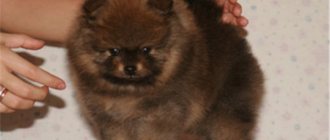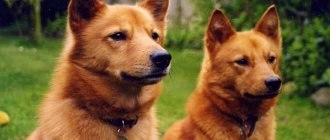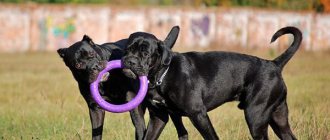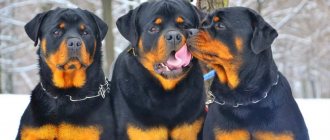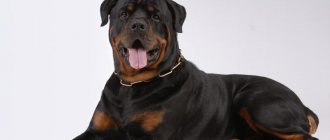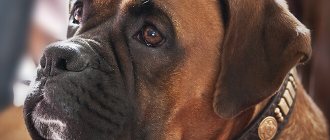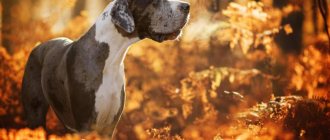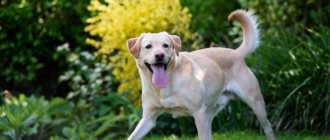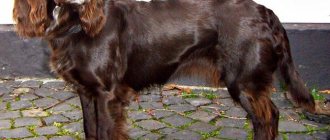| Type |
|
| Size | large (26-50kg) |
| Main features |
|
| Included in |
|
| Frequent illnesses |
|
| Intelligence | 95% |
Rottweiler. Video
Rottweiler dogs are strong and intelligent protectors; you can trust them with your life. He is also a dog for the whole family and the kindest creature. He is a loyal and understanding friend, with whom it is pleasant to have fun, and if necessary, you can cry into his broad chest. That's what fans of these powerful animals say.
However, the breed also has many opponents. Opinions about Rottweilers are very contradictory, and sometimes downright negative. Someone is afraid of these dogs and considers them terrible monsters. Some people believe that these ferocious animals have no place on city streets; they are as dangerous as weapons.
Let's find out what kind of dog the Rottweiler is and why there are such different reviews about it. We will also tell you how to properly raise and maintain such a pet and who should not have one.
Tail docking
Tail docking surgery on a Rottweiler is easier than ear cropping. Firstly, you can do without surgery.
A common way to shorten puppies' tails is with a bandage. A tourniquet or elastic band is applied at a distance of 2/3 of the entire length from the base of the tail. The tissues stop receiving nutrition and die; the tip falls off on its own within a week.
If the Rottweiler is more than 1 month old, surgery is required. Similar to the ear cropping procedure, the dog is placed on a table, inhalation ventilation is placed, and general anesthesia is administered using alcohol-chloroform vapor and antipsychotics.
The desired area on the tail is shaved and filled with antiseptic. The skin is pulled to the base and a portion is quickly cut off at the junction of the vertebrae. The excess skin is pulled back and sutured. A bandage with an antibacterial and antibiotic solution is applied on top.
History of the Rottweiler breed
The Rottweiler is one of the oldest European breeds; according to some sources, it is more than two thousand years old. The ancestors of these strong dogs were known back in the Ancient Roman Empire, their images were found on frescoes of that era. Domesticated animals roamed with Roman legionnaires. A herd of cattle was always sent on a campaign with the army; this was a food supply. And powerful short-haired dogs were responsible for its protection, which sometimes took part in battles. This is how they entered the territory of modern Germany.
And when the Germans expelled the invaders from their land, the dogs remained to serve their new owners. Local peasants specialized in raising large beef cattle, and the hardy and calm ancestors of the Rottweiler drove bulls and cows to selling points. A little later, they began to be used for transporting goods; powerful dogs delivered carts of meat to the market.
The owners trusted their four-legged helpers to guard not only their livestock, but also their money. After selling the meat, the peasants hung a wallet with the proceeds around their necks. For such comprehensive assistance, Rottweilers received the nickname Metzgerhund in their homeland. Translated from German it means “butcher’s dog.”
The first Rottweilers were not bred artificially in professional nurseries; they went through a more serious selection - folk selection. The peasants kept only the strongest dogs, capable of hard work, distinguished by intelligence and courage. Weak, cowardly and disobedient puppies were culled without pity. Thanks to this approach, the ideal four-legged universal assistant was formed. The Rottweiler was a cattle dog, guard dog, protector and cargo carrier. Find out more about another German breed - the Giant Schnauzer
In the 18th century, these dogs were especially popular in the German town of Rottweil, which gave the breed its modern name. By the end of the century, large, broad-chested dogs had spread throughout all regions of Germany. However, in the 19th century, Rottweilers almost disappeared. They have lost their day jobs due to technological advancement. Livestock was no longer driven over long distances, but began to be transported by rail.
In the homeland of the breed in the town of Rottweil, a bronze monument to the Rottweiler was erected in 2007. A little earlier, in 2005, an installation of 500 plastic dog figurines opened there.
The number of Rottweilers began to decline sharply. It got to the point that in 1882, only one representative of the breed took part in the all-German exhibition in the town of Heilbronn, and not of the best quality. Dog lovers are wondering whether it is worth cultivating an almost extinct breed. But practical Germans could not forget the excellent performance of these dogs. Fortunately, Rottweilers quickly found other uses. They joined the army and police.
Rottweilers began their career in law enforcement thanks to a fortunate coincidence of circumstances. In Hamburg, a certain police officer quarreled with drunken sailors. He set his faithful dog on his opponents. And the Rottweiler won a convincing victory, dispersing several people. Newspapers trumpeted the incident throughout Germany. This was in 1901, after some time these dogs were officially recognized as police dogs.
At the beginning of the twentieth century, the breed received a new impetus for development. Many people wanted to have a home bodyguard. At the same time, several clubs for breed lovers opened. Professional dog handlers became interested in her, they began to bring the exterior to uniform requirements and improve working qualities. Until then, Rottweilers were of different colors and smaller than they are now.
In 1913, a standard was approved that excluded dogs with white spots, but various colors were still accepted. In 1921, a single National Rottweiler Club was created in the city of Stuttgart. His merits are the recreation of the ancient breed and its popularization. By the way, this association still exists today. In 1923, the Rottweiler acquired its modern characteristics, including its characteristic black and tan coloring and height.
During the second half of the twentieth century, the breed changed slightly. The latest international standard for the Rottweiler was adopted in 2000. Dog handlers decided to abandon tail docking.
Main characteristics
The popularity of Rottweilers changes at different times, but everyone always knows about them. If people need a faithful friend who will accompany them anywhere in the world and in any weather, will always protect and protect them, and is not particularly prone to fatigue, then this breed is chosen.
However, the breed is not popular in families with small children , because due to its sluggishness and large mass, the dog can touch and knock over a child without meaning to.
Appearance
The dog has a harmonious build, thanks to which it allows you to achieve your goal much faster than many of its brothers. Huge strength is concentrated in the short legs , and the wide head gives the appearance greater aggressiveness or, on the contrary, cheerfulness, depending on the situation. The dog's body is very massive, which is the first thing that catches the eye of an unprepared person.
Lifespan
Unfortunately, large breeds of dogs also have their disadvantages, from which even the historicity of the breed cannot save them. Rottweilers live on average 10 to 12 years , but with very good care they can live up to 14-15 years. Cases have been repeatedly recorded where a dog lived to be 17 years old, but this is the exception rather than the rule.
The breed has a harmonious build
Character
The dog is very smart and cunning , which should not be underestimated. If your pet suddenly stops following the command and looks with an uncomprehending look, then this can only mean that he is deceiving you. Thanks to its high intelligence , the Rottweiler is not just a guard, but a family member who will love his owners and their children, and will not abandon him even for the sake of a very desirable profit. There is not only dog loyalty here, but also a division of prerogatives.
Despite many positive character traits, the pet is naturally close to a pug - he is terribly lazy , which can cause health problems. You need to keep your dog busy (running, jumping, training and just playing), and as much time as possible.
This is a very peaceful and humanized dog that easily accepts communication with other people and animals, but at the slightest hint of a threat it changes dramatically, instantly turning into 60 kg of aggression.
In the family he behaves affectionately, like a cat, but if there are small children, problems may arise. The dog will never purposefully offend his owners’ child, even if he causes significant discomfort. But the large dimensions and huge mass do their job, which is why it is enough to carelessly touch a child once and he may fall painfully. In addition, dogs love to eat delicious food, which is why you will always have to keep baby food out of reach .
“German” is a well-deserved authority among search dogs, rescuers and security guards . Read our description of the German Shepherd breed and see for yourself.
A huge white dog, covered with long hair, as if curled into “dreadlocks” - this is how you can describe this unique dog. Find out more about the Hungarian Cattle Dog on our website.
Training
In matters of training, it is very pliable, but natural laziness coupled with intelligence still takes its toll, which is why the training process may be slower. Training can be directed in several directions - hunting , protecting the territory and accompanying the owner , as well as grazing . During its formation, a dog can begin to fight for leadership with its owner, so at this stage it is better to turn to trainers who will help you pass the stage painlessly.
But even without professional training, this breed is naturally an excellent watchdog . Remarkable hearing and coordination in space will not allow any unexpected guest to pass unnoticed, after which it is a matter of technique. In this area, it is very easy to teach a dog basic things so that the animal does not get hurt during protection. He will selflessly defend the object entrusted to him to the end, but such fearlessness can also show the other side of the coin, which must also be remembered.
This dog is a wonderful watchman and guard.
Appearance of the breed
The Rottweiler is an athlete, powerful, strong and agile. He is tall, on average 65 centimeters, weighing 50 kilograms or more. At the same time, there is almost no fat, only strong muscles. Thanks to them, the dog moves confidently and freely.
The Rottweiler's head is massive, with strong jaws and intelligent, attentive brown eyes. He calmly but vigilantly studies the world around him. If something goes wrong, the dog will react immediately. The dog has a wide nose with large nostrils and a scissor bite. The ears are small and drooping, set far apart and set high. Thanks to them, the head appears wider.
The heaviest representative of the Rottweiler breed from Great Britain weighs more than 95 kilograms. However, this is not the norm, but the result of overeating.
This dog's neck is muscular, but rather dry. There should be no suspension. The back is strong and level and goes into a strong loin, and then into a wide, slightly rounded croup. The chest is very voluminous, and the stomach is not toned. The tail continues the line of the back. It is lowered if the dog is calm. Straight limbs are not close to each other. The paws are rounded with compressed toes, hard pads and black strong claws. The Rottweiler moves confidently and freely. Usually at a trot.
The skin is dense and fits well to the body. If the dog is alert, small folds may form on the head. The coat is of medium length on top, hard to the touch and dense. The undercoat is shorter and slightly softer. The only color option is black with red-brown tan.
Disadvantages are considered to be too light a skeleton and underdeveloped muscles, a small, long or too short head, a pointed muzzle, a hooked or arched back of the nose, weak jaws, heavy or flabby ears, light eyes, as well as too large, a thin neck or with excess skin. . Other deviations include a disproportionate body with an uneven back and sloping croup, an incorrectly positioned tail, and weak, very long limbs. Soft guard hair and complete absence of undercoat are serious defects, as are unclear tan patterns and pale coloring.
Reasons for disqualification will be inconsistency with the gender type, problems with the bite, an incomplete set of teeth, different-colored eyes, an irregularly shaped tail, wavy or too long hair, and white marks anywhere. Cowardly, timid, fearful, angry and nervous dogs are removed from the ring.
Dimensions and weight
This table shows the average height at the withers and weight of Rottweilers:
| Floor | Height at withers | Weight |
| Male | 61-70 cm | About 50 kg |
| Bitch | 56-65 cm | About 45 kg |
As can be seen from the table, male Rottweilers are noticeably different from girls of this breed. In addition to being taller and heavier, males look more massive and muscular.
Rottweiler character
Perhaps no other breed causes so much controversy and rumors. Some people believe that this dog is a vicious beast and are afraid of it. Others claim that there is no kinder, calmer and more obedient dog than the Rottweiler. Surprisingly, there is truth in both judgments.
According to the breed standard, the Rottweiler must have a balanced character, a friendly and peaceful disposition. He is smart, devoted to his owner and his family, loves and knows how to work. At the same time, he is a born guard and protector. This means that he is wary of strangers and carefully observes the situation around him. If a threat arises, the dog will intervene. Moreover, he will fight back fearlessly, decisively, without warning and without regard for his own safety. Once a Rottweiler gets into a fight, it is very difficult to stop it. However, after the incident he quickly calms down. This breed is not known for its vindictiveness and excessive nervousness.
Some dog handlers call the Rottweiler a “hard dog.” So they emphasize the strength and courage of his character. This dog quickly forgets unpleasant and painful sensations; they do not affect his subsequent behavior. The Rottweiler is difficult to anger; he is able to remain calm for a long time and is not influenced by fuss and provocations. Under any circumstances, he is distinguished by enviable balance.
Now imagine that a dog with such a character fell into the hands of a weak or unbalanced person who sees danger in everything and uses the dog as a weapon. The Rottweiler will grow up with a crippled psyche; he will become aggressive, uncontrollable and dangerous to others. The same will happen if the owner is cruel and treats the pet roughly or if the dog is left to his own devices. Simply put, the problem is not the bad character of the dog, but the mistakes of upbringing and an inept or inadequate owner.
The breed's breeder, Countess Agn von Hagen, accurately described the dog's character: “This is a strong fellow who accurately distinguishes between the concepts of “duty” and “outside duty.” A selfless defender becomes a lamb at home. His intelligent eyes can light up with a fear-inducing brilliance, but for a friend they express simplicity itself. The Rottweiler is not elegant, but he has nobility of strength, a cheerful disposition, self-esteem and a deep soul.”
A properly trained Rottweiler is peaceful, affectionate and well-managed. This is a family dog. Although only one person is singled out and recognized as the rightful owner and leader of the pack. The Rottweiler is lenient and tolerant towards children. However, he is unlikely to make a nanny. You should not leave a large dog alone with a baby. Still, this breed is intended for other purposes.
Calm by nature, Rottweilers really do not like nervous environments, noise, fuss and screams. They will find it difficult to endure conflicts in the family, suffer and try to reconcile the warring parties. But sooner or later this will affect the pet’s behavior; he may break loose and become aggressive.
In an atmosphere of calm, the Rottweiler will show its best character traits: equanimity, confidence and poise. A black-and-red dog will not get into a fight without reason, will not bark in vain, and will not impose itself or pester you. This dog with a truly German nature is straightforward, simple-minded and fearless.
Rottweilers, especially young ones, can show hostility towards strange dogs. They themselves rarely start fights, but they can respond harshly to provocation. Therefore, they should not be let off a leash in the city. And to reduce conflicts, the puppy needs to be actively socialized: introduced to other pets and different people.
Feeding
For a Rottweiler to live long and happily, a balanced diet is necessary. The diet of young shoots should include porridge, cottage cheese, chopped beef, eggs, and vegetables (except cabbage).
For adults, flour products, pasta, fish, offal, and fruit are added to the menu. The bowl should be double - for water and food.
You can consider the option of dry food. In this case, choose only reliable brands - German Wolfsblut, French Royal Canin. Be sure to treat your dog with a vitamin complex.
Pros and cons of the breed
The Rottweiler, like other breeds, has advantages and disadvantages. We will not talk about problems caused by gaps in education and training. Let us name only objective qualities.
The undoubted advantages of dogs of this breed include:
- Balanced temperament;
- developed intelligence;
- devotion and affection;
- security and protective qualities;
- ease of maintenance and care.
The disadvantages of the breed include:
- Large dimensions;
- careful education and training is necessary;
- requires a long and active walk;
- there is a tendency to obesity.
Brief historical background
The history of the Rottweiler breed began in those distant times when Roman conquerors walked the earth. The Romans conquered various cities and captured large territories. Next to them there were always powerful and hardy dogs that drove and protected livestock and herds of horses.
When the invaders conquered German territories, they lived on the fertile lands for about two hundred years. However, over time, the Swabian tribes were still able to drive out the Romans. Moreover, the Roman dogs remained. The Germans were able to appreciate the merits and characteristics of animals and took them into service - to protect and protect livestock.
In the nineteenth century, butchers who lived in a city called Rottweil, which translated means “red tiles,” decided to improve them. They needed guards-treasurers who could hang the money received from the transaction around their necks and not be afraid that the profit would be stolen.
They crossed Roman dogs with local shepherd dogs and created a new breed. It is the dogs resulting from such crossing that are considered to be the ancestors of the modern Rottweiler. The name of the breed, naturally, is taken from the name of its hometown.
In those days, German dog breeders did not care about the appearance of Rottweilers. Only impeccable submission and performance of necessary functions - this is exactly what the breeders sought. And we can say that they have achieved quite good success. Rottweilers began to be used for driving various herds, guarding the assigned territory and cargo during their transportation.
Due to exposure to such extreme factors as blows from hooves or attacks from predators, Rottweilers have developed such working qualities as courage, endurance, power, low pain threshold, the ability to decisively and quickly perform the correct action, and controlled aggression.
At the end of the nineteenth century, it was impossible to drive livestock over long distances, as this contributed to the spread of various infections. They began to build railways. Therefore, Rottweilers remained out of work.
Gradually, the breed began to disappear, but the German Rottweiler Fans Club, organized in 1907, was able to save the dog population. Members of the society began to work on restoring the breed, taking its representatives to various exhibitions and competitions.
The characteristics of Rottweilers revealed working qualities that contributed to the fact that these dogs became ideal guards and devoted companions. Therefore, both in the USA and in England, these animals were received with a bang and were happy to use their official functions, gradually turning the Rottweiler into a service dog.
Rottweilers began to help the police in detaining violators and protecting government facilities. Firefighters carried water on the backs of Rottweilers, and rescuers sent dogs to fight the consequences of various natural elements - to look for people buried under the rubble. And in our time, dogs of this breed are used in rescue and search operations.
If you compare a modern representative of the Rottweiler breed and its medieval ancestor, you will notice that the dog’s exterior has not changed at all. But some characteristic features have undergone slight changes, because breeders are constantly improving the working qualities of Rottweilers.
In the mid-twentieth century, dogs of this breed achieved the title of a kind and caring pet, but did not cease to be excellent guards.
Representatives of this breed came to Russian territory in 1914, where they easily got used to our harsh climate. Dogs protected domesticated livestock from attacks by various predators in Siberia and the Far North.
Raising and training a Rottweiler
Dog breeders say: “If you trained a German Shepherd, you did nothing, but if you trained a Rottweiler, then a lot.” This does not mean that this breed does not learn commands well. It’s just that training, and most importantly raising a Rottweiler, will require more patience and perseverance.
Rottweiler puppies quickly realize that they are strong and try to take their place as the leader of the pack. Such attempts should be calmly, but methodically and firmly suppressed. However, do without violence and raising your voice. Dogs easily read strict and confident intonation; they respect the strength of a person. The Rottweiler will be flexible and balanced if the owner has proven that he is a true leader.
From the first days, the puppy needs to be explained what “good” and “bad” are. We must immediately stop wrong actions and praise them for obedience. For example, you can’t bite a person, but you can tear a toy. Moreover, the whole family must adhere to the same principles. Then the little Rottweiler will learn his lessons sooner.
At the headquarters of the all-German breed club for more than 100 years there has been a poster with the inscription: “The Rottweiler was, is and remains a working dog.” In other words, this dog should not become a couch potato and a slacker; he must be trained and be entrusted with some tasks. Then the Rottweiler will feel needed.
They begin training by getting used to the nickname, then move on to more complex tasks. By about three months, the puppy can learn the first commands - “no”, “place”, “come to me” and others. It is very important that he gets used to walking nearby, otherwise it will be impossible to walk calmly. Even a six-month-old Rottweiler kitten can drag away an adult without much effort. By the way, most representatives of the breed are pronounced “food lovers”, so they master science well, supported by tasty treats.
It has already been mentioned above how useful early socialization of an animal is for preventing unwanted behavior. The little Rottweiler must understand that the world around him consists of friendly people who can pet him. To do this, he needs to be allowed to play with children and communicate with passers-by if they show interest. Then the dog will grow up friendly and will not show unreasonable aggression. And then you need to teach the puppy not to take other people's food from strangers, not to leave with them, and so on.
Up to a year, the owner and his Rottweiler must undergo a general training course, preferably under the guidance of a professional dog handler. And then you can study the protective guard service; there are more complex and simplified versions of this course. Recently, another type of training has become popular – the UGS (controlled city dog) course. During classes, pets learn the rules of behavior on the street, in crowded places.
Training Basics
Due to the laziness factor, a dog may refuse training, but pliability is also inherent in this breed. Accordingly, if you train your dog correctly, it will follow all commands quite well.
Training should consist of the following areas:
- development of hunting skills;
- protection of possessions;
- grazing.
Noting the fact that a dog is a fighter by nature, it can enter into unequal confrontation with its owner in the struggle for a leading position. In this case, you cannot do without the help of an experienced dog handler. Professionals with special training skills will help you cross this stage in your pet’s development with the least amount of stress and loss of relationship between the owner and the animal.
A Rottweiler whose main characteristic is watchdog skills can develop this feature even without special training. This is due to the fact that guard qualities are inherent in these dogs by nature. The dog has exceptional hearing, as well as coordination of movements, so we can say that uninvited guests are simply obliged to bypass the property guarded by Rottweilers. So in the field of security, as the education of a Rottweiler shows, dogs practically do not need training, they themselves know what to do, and then it’s a matter of technology.
Pets will always defend the territory and residents of this property, so for uninvited guests, a dangerous visit may turn out to be a not entirely pleasant side.
Care and maintenance
The best place to keep a Rottweiler is a country house with a large plot or a spacious enclosure in the yard. In the northern regions, it is advisable to equip him with a warm booth. Severe frosts are a serious test for a short-haired dog, although the undercoat becomes thicker in winter. By the way, massive black dogs do not tolerate heat well. Therefore, in summer, drinking water should be constantly available, and it would also be good to equip a bath or shower for the dog.
The Rottweiler will also take root in an apartment, but it will need a lot of space and the owner will need time for long walks. A large, energetic dog needs to exercise a lot, otherwise it will become loose and lethargic.
You will have to walk your Rottweiler for at least one and a half hours a day. Ideally, you need to organize active games, bike rides and jogging; in winter, you can entrust the dog with towing a skier or sleigh. At least a couple of times a month, arrange a country vacation for your pet so that he can frolic and run around without a leash.
In the city, we must not forget about the rules for walking large dogs. In crowded places, the Rottweiler must be muzzled and on a short leash.
Wool and hygiene
Caring for a Rottweiler is not at all difficult, especially if he lives in the yard. And even in an apartment, it is enough to brush a short-haired dog with a stiff brush or silicone glove once a week. During molting, you need to do the procedure more often. You need to bathe your dog if it is really dirty. Moreover, you should not use aggressive detergents, they can cause skin irritation. Only mild veterinary shampoos.
You should inspect your dog's ears weekly and remove accumulated plaque and dirt with a cloth containing hydrogen peroxide or veterinary lotion. If you notice redness, you need to observe and find out the cause with the help of a veterinarian. You should also brush your pet’s teeth with a special paste or wipe them once a week. To prevent oral diseases, you can give hard vegetables or industrially produced treats to chew. The claws of dogs that walk frequently and actively wear down on their own. But in the cold season they can grow back. To ensure that the claws do not interfere with movement, you need to periodically check their length and trim them using a nail clipper.
Nutrition
A large muscular dog needs to be provided with adequate nutrition. Adults are usually fed twice a day, puppies - four, and then three. It is worth considering that this breed is prone to overeating and weight gain.
To ensure that the puppy’s skeleton is formed correctly, use bowls on a special stand or bracket for feeding. Their height needs to be adjusted as the pet grows.
Finding a balanced diet from natural products is quite difficult. In addition, a large dog eats a lot, about two and a half kilograms of food a day, but maybe more. The diet should include lean meat and offal (except pork), and sea fish. They are given raw, after severe freezing. The source of carbohydrates is cereals, vegetables and fruits. Once a week you can have a fermented milk day. You cannot feed your dog dishes from the “human” menu: sausages, confectionery, pickles, smoked meats. Be careful with citrus fruits and legumes. For prevention, a course of vitamin and mineral supplements should be taken twice a year.
Older and sedentary Rottweilers often suffer from obesity. If the owner notices that the pet is overweight, he should cut back on the diet. First of all, you should reduce the amount of carbohydrate foods.
Ready-made dog food is an excellent option for a Rottweiler owner. It is better to buy them in large packages. By the way, it is convenient if the granules are large - because of this, the dog eats more slowly and additionally brushes his teeth.
Owner reviews
My husband really wanted a Rottweiler. I was just raving about it. I couldn’t resist him and one day I became the owner of a two-month-old puppy, who was named Ray. Ray was a very smart guy. Within about a month, he learned to do all his dirty deeds on the street. I missed one very important point - education. As a result, he did not perceive me as an owner in any way. He did what he wanted. He even showed more respect to the cat. But he definitely took my husband for the leader. He never coddled him and always spoke in a commanding voice. Ray is no longer with us. Despite my great love for him, I will never own a Rottweiler again, as this breed does not suit my personality. Well, I can handle it.
Valeria, Ryazan.
Dogs have always lived in my house. Bolonka, Chihuahua. But I always dreamed of a big dog. One day I came to the kennel and couldn’t leave without a puppy. I understood that I was not doing a completely deliberate act, but I never regretted it. I loved my Rudolph with all my heart. We walked together and went jogging in the morning. He really liked to rub his fur against the same place on the wall, and soon there was a black spot there. This breed is not picky when it comes to food and care. But you need to monitor your weight, as Rottweilers are prone to obesity. At that time, I was already living separately from my parents, but my dad began to visit more and more often. And he clearly didn’t come to me. He has become attached to Rudolph with all his heart and will persuade me to give him to mom and dad. They spoiled the dog, feeding him sausage and dumplings. Because of this, Rudik began to gain weight and eventually died due to heart failure. My dad had to experience the fact that this breed is an excellent guard. One late evening, when he was walking with Rudolf in the park, a man approached him with a knife in his hands. Our dog, who was running in the bushes at that moment, immediately rushed at him. Dad barely managed to tear off the robber's dog, but Rudolf received 4 deep stab wounds. We barely managed to save him then. Insanely strong, loyal and the best breed.
Olga, Chisinau.
Health and illness
Rottweilers are dogs bred by folk selection, and therefore are distinguished by fairly good health. If the pet does not overeat and is not burdened with excess weight, it rarely gets sick. On average, they live up to 12-13 years, and this is a lot by dog standards.
However, if the Rottweiler moves little and eats a lot, sooner or later problems with the joints will begin, and there may also be diseases of the cardiovascular system. If your dog begins to get tired quickly, has difficulty breathing with little exertion, or moves strangely, you need to contact a veterinarian.
Sometimes representatives of this breed have food allergies and dermatitis. Therefore, new foods should be introduced into the diet gradually, in small portions. And if you notice scratching or redness on the skin, be sure to consult a veterinarian.
It is very important not to forget about treating your pet for internal and external parasites. Especially on the eve of tick activity. They carry dangerous diseases, and are completely invisible in black fur.
Health problems
Rottweilers naturally have excellent health, especially if kept in normal conditions. But, like other animals, they can be susceptible to the following diseases:
- flatulence (bloating);
- articular dysplasia and other joint diseases;
- diabetes;
- obesity;
- eye diseases: retinal atrophy, cataracts, entropion;
- kidney disease;
- diseases of the nervous system.
It is worth noting that many Rottweilers can snore in their sleep. Sometimes this feature leads to coughing. If this happens occasionally, then there is no need to worry. But if the cough persists, it may be a symptom of heart or lung disease.
How to choose a Rottweiler puppy
The Rottweiler is perfect for an athletic and energetic person who has enough time and patience to exercise his pet. It is categorically not recommended to have a breed for a child; he may not be able to cope with a large dog. A sedentary and passive person, as well as an impatient and nervous person, will also find it difficult to properly raise a dog.
If you get a Rottweiler, you will get a reliable and devoted friend, a partner for long walks and active games. In one canine face you get a companion, bodyguard and security guard.
Taking a Rottweiler kitten of unknown breeding is dangerous. This dog grows up big and strong, so it is important that she has a healthy psyche. You only need to purchase a puppy from a nursery or from a breeder who will provide you with documents confirming the breed: the club’s puppy metric. In this way they ensure that the puppy meets the standard requirements for appearance and character.
If you want to raise a dog show champion or take part in breeding, choose a puppy based on the description of the exterior. Your future pet must meet the breed standard as much as possible. Take a closer look at how the kitten behaves. Shy, too lethargic, too aggressive - not the best choice. Pay attention to the puppy's health condition. He shouldn't itch, he has clean ears and eyes, and shiny fur.
Pedigree varieties
The breed does not have any varieties as such, but several national standards stand out:
- Germanic – a classic type of Rottweiler, on the standardization of which the FCI standard is based;
- English - based on German, but English breeders sought an imperturbable character in dogs, without losing their protective qualities;
- American – breeders from America focused on the anger and size of Rottweilers, so their dogs are larger and far from friendly.
In addition to them, there are also Rottweilers from such breeding lines as:
- Finnish - with a long muzzle and ears and a lighter color;
- Norwegian - with longer legs and a heavier body;
- Austrian - with a working type of structure, shorter stature.
IMPORTANT!
In addition, there are frequent cases of the birth of so-called dwarf Rottweilers, but it is important to remember that this is not a subtype of standard representatives of the breed, but the result of a failure in genetics due to improper selection or illness of the parents.
How much do Rottweiler puppies cost?
Rottweiler puppies are not too expensive when compared to other breeds. But the price range is quite wide. Nurseries offer to buy them for both 10 thousand rubles and 100 thousand. The cost of a particular puppy depends on the class and merits of the parents.
A pet-class Rottweiler puppy, which is only suitable for the role of a pet, will cost from 5 thousand to 10 thousand rubles. Breed class - these are dogs that can participate in breeding, sold for 10 - 20 thousand rubles. And show-class puppies, also from a titled couple, are valued several times more expensive. On average, they are offered for 20 - 40 thousand rubles.
Distinctive features
Once you see this breed, you will no longer confuse it. The height of the withers reaches 68 cm (male) and 63 cm (female). At the same time, dogs cannot be called heavyweights; their average weight ranges from 40 to 50 kg.
The best description of the Rottweiler is given in the Fédération Cynologique Internationale Standard:
- the head is of medium size, the transition from the forehead to the nose and cheekbones are strongly pronounced;
- the muzzle is narrowed, the jaws have normally 42 teeth;
- the ears are hanging, widely spaced, shaped like a triangle;
- the eyes are black-brown, the cut is almond-shaped;
- the tail is long, although there is a docked (cut) version of up to 2 vertebrae;
- the neck and paws have strong muscles.
Photos of our visitors' Rottweiler
Key points in training
Representatives of the breed are strong and confident. They need a steady hand and a leader. A beginner will not be able to cope with such a dog. The owner must always prove his dominance. Usually the Rottweiler chooses one person to listen to. To avoid such a situation, care for the pet must be divided among all family members, and a schedule for walking and feeding must be drawn up.
Training a puppy begins at 3-4 months, but raising it from birth. The dog must know its place. A person should not allow a dog to eat from the table, beg, or sleep on the master's beds. It is absolutely forbidden to treat an animal roughly, beat it, shout or call it names. A Rottweiler can not only be offended, but also attack in defense. It is best to use the motivational method by luring the puppy with treats or toys. Suitable punishments include deprivation of one meal, gentle jerking, and a stern look.
The pet must learn its name well before training begins. Usually this happens by 4 months. Then the puppy is already able to learn the necessary commands:
- "It is forbidden";
- "Near";
- "Quiet",
- "Voice";
- "Sit";
- "Place".
Pet nickname
If the puppy has a pedigree, then most likely the kennel gave him a name. It will be pompous, majestic and... most likely unpronounceable. In this case, a new everyday nickname is either invented or created based on his name from the nursery. Let's imagine: let's say the puppy's name is Alistair von Britt. Naturally, if you call him this way in everyday life, it will look stupid and not appropriate. In this case, you can give the dog a completely new name or use part of an existing one: Ali, Lis, Britt.
There are several recommendations for a nickname for a pet, but often what the pet will be called is the owner’s choice, based on his vision, and no one has the right to impose something on him.
- You should use the letter P in a nickname with caution - this can be perceived by your pet as aggression or growling.
- The name should be easy to pronounce, clear and sonorous. It is better to use no more than two or three syllables.
- The name should not sound similar to any of the commands, as this may cause confusion when training the dog.
- We do not recommend calling your pet a rude, ugly, or offensive word. Remember that a dog is, first of all, your friend and companion.
- German names are quite popular as nicknames: Wilhelm, Rudolf, Otto, Gunther, Gretel, Gretchen, Zelda, etc. They sound strong, warlike and majestic, just like the pets themselves. But what if you wanted to name your pet Peach? It's okay. A very good name. Names for girls and boys of Rottweilers should preferably also have gender characteristics (naming a boy Alice will not be particularly nice in relation to the pet, and even on the street, when calling a pet, passers-by and neighbors will have questions).
- Well, of course, try to come up with a name that will not be the most popular. Otherwise, when you try to call your pet, you risk collecting a good half of all the neighbor’s dogs (and not only them) in the yard.
Métis
Let's look at what kind of mixed breeds exist and see in the photo what a cross between a Rottweiler and a German Shepherd looks like, a mixture with a Labrador and other dog breeds.
German Shepherd mix
Malchover is a cross between a German and a Rottweiler. A muscular, calm, loyal, intelligent and self-confident dog has become a good friend to man. The weight of a large dog is 50 kg. He inherited the color from the Rottweiler, and the muzzle and ears from the German.
Metis has the following advantages:
- good intelligence;
- excellent watchdog qualities;
- easy to learn;
- devotion;
- Ability to remain calm in emergency situations.
Important! Malchover can be dangerous. If a dog lives next to a weak-willed person, then he prefers to dominate and restore order
Only a professional can train a dog.
With Labrador
The mixed breed is called a labra-rotweil. This complex canine artifact inherited good intelligence, conformation and temperament from its parents. Dogs are little known to people, because obtaining an ideal heir can be achieved after long and painstaking work.
Attention! Despite the strong Labrador blood, German drive and combativeness take over. Rottweilers are one of the twenty most vicious fighting breeds, so puppies can be dangerous to humans.
With a pit bull
This mestizo was called a pit bull terrier. The dog is different:
- increased endurance;
- energy;
- fearlessness.
The color can be anything from solid black to black with brindle markings. The coat is smooth, short and shiny. The chest is wide and massive. The legs are of medium length and muscular.
The mixed breed is slightly smaller in size than a purebred Rottweiler. The weight of an adult is 30-40 kg.
Important! This breed is not suitable for everyone. The owner must devote a large amount of time, properly raise and train
Otherwise, the dog will feel lonely, and the psyche will change not for the better.
Staffordshire Terrier
This is a cross between a Stafford and a Rottweiler. The dog has the following features:
- the dog is large in size and has well-developed muscles;
- endurance;
- calm character;
- loves to communicate with the owner and other dogs.
There are aggressive individuals who inherited a malicious character from their parents, were raised that way, or were kept in harsh conditions. For training to be productive, the owner should be patient and remember consistency.
The dog benefits from regular physical activity. This way she can maintain physical fitness and be in a good mood.
Mongrel mix
The mestizo “nobleman” is not distinguished by his impeccable character. Requires increased attention and love from the owner. The dog's owners claim that it is difficult to train, and its most important trait is arrogance.
The dog has good intelligence. He can easily open any door, understands people, and gets along with other pets. Despite their attractive appearance and pretty face, dogs of this breed do not participate in exhibitions.
Other famous hybrids
There are several other breeds obtained by crossing the Rottweiler and other dogs. Here are some unique unions:
- Doberman and Rottweiler. Metis took all the traits from both breeds. This is a stately dog with a strong character, courage and endurance. Usually the color is black with red tan.
- Husky and Rottweiler. The dog has a friendly character and affability. He chooses one master from the whole family, and obeys only him. The large dog reaches a height of 60 cm. The color can be pure black, or mixed with the colors of the husky’s parent.
- Alabai and Rottweiler. Metis reacts aggressively to unfamiliar people. However, he will always protect and love his family. The dog is large and can weigh up to 100 kg.
Still, selection is unpredictable. If some mestizos are ideal, then some have a disgusting character. Many dogs are prone to gluttony and laziness. It is difficult to force such animals to do anything, much less learn.
Attention! Without professional training, any mestizo will turn into a dangerous enemy. There have been cases when dogs attacked small children. The photo shows Rottweiler mixes
The photo shows Rottweiler mixes.
Doberman and Rottweiler:
Husky and Rottweiler:
Alabai and Rottweiler:
Tips for choosing a puppy
You shouldn't take on something you can't handle. Rottweiler puppies born from parents with a weak psyche are a real threat, both to you and to others. We can talk about an unstable mental state if we are talking about a mestizo or a phenotype. It is rare, but even in purebred litters, there are puppies of “disputable quality”.
If you want to choose a Rottweiler puppy that will grow up balanced and become a full-fledged member of society, contact only trusted nurseries. Breeders who have nothing to hide keep a detailed inventory of all dogs and litters, monitor their “graduates” after the sale and will be happy to provide you with all the data. If you notice that the seller is being disingenuous or cannot clearly answer questions, turn around and leave. You should not get involved with people for whom the main indicators of the quality of a breed are size, anger and beauty.
